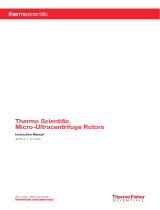Page is loading ...

Thermo Scientific Nalgene Labware Care and Use Instructions
General Cleaning
For most general applications, plastics may be washed in a mild (non-alkaline is recommended) detergent, followed by
a rinse with tap water, and then distilled water. Do not use abrasive cleaners or scouring pads on any plastic labware.
Do not use strong alkaline cleaning agents with polycarbonate.
Autoclaving
To prevent baking contaminants onto the surface of the plastic, all items should be carefully cleaned and rinsed in
distilled water before autoclaving. Do not autoclave containers (except those made of fluorocarbons) containing
detergent or wetting solutions.
Always completely disengage threads or remove closure before autoclaving.
Polystyrene, polyvinyl chloride, nylon, styrene, acrylonitrile, acrylic, and low- and high-density
polyethylene are not autoclavable under any conditions.
Society of Plastics Industry (SPI) Recycling Codes are molded into the bottom of all injection blow-molded or extrusion
blow-molded bottles, 500 ml and larger.
A

© 2012 Thermo Fisher Scientific Inc. All rights reserved. All trademarks are the property of
Thermo Fisher Scientific Inc. and its subsidiaries.
www.thermoscientific.com
8-1007-22 0912
For more information contact Technical Support at: technical.nalgene@thermofisher.com
Visit www.thermoscientific.com product resources pages for complete product use guidelines.
Printed on Rolland Enviro100 Print, which contains 100%
post-consumer fiber, manufactured using renewable
biogas energy and is certified EcoLogo, Processed
Chlorine Free and FSC Recycled.
100%
FPOFPO
/









